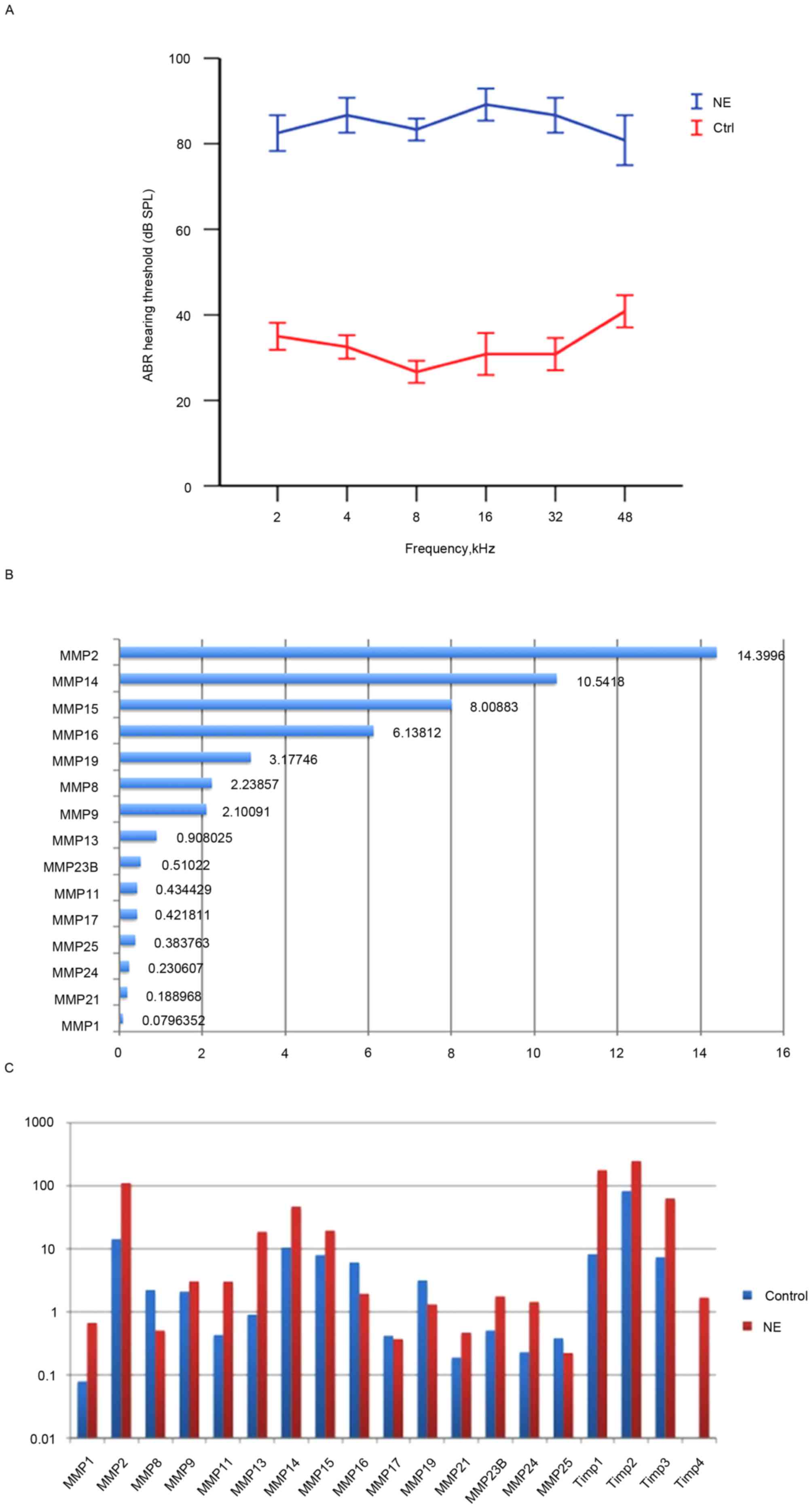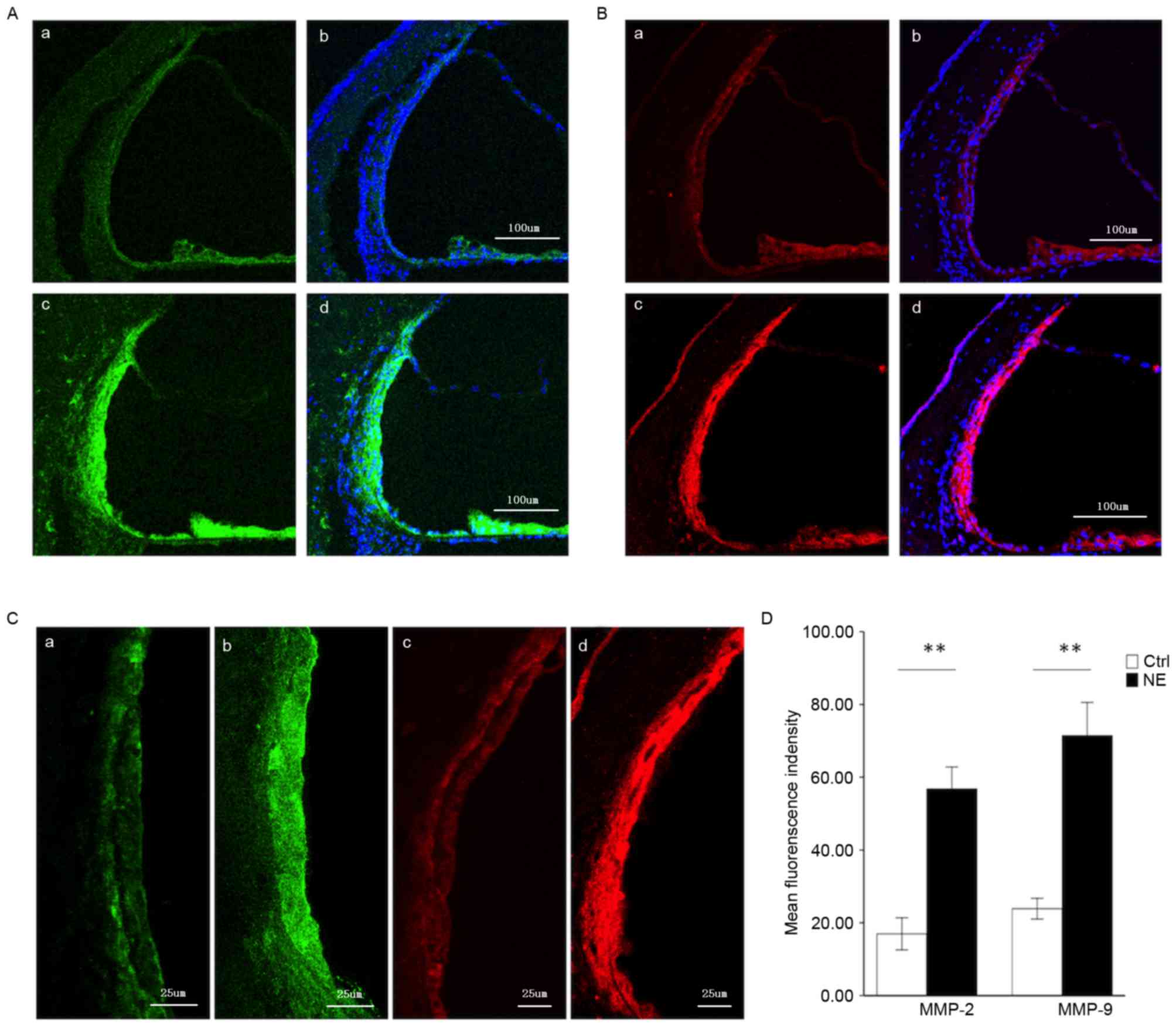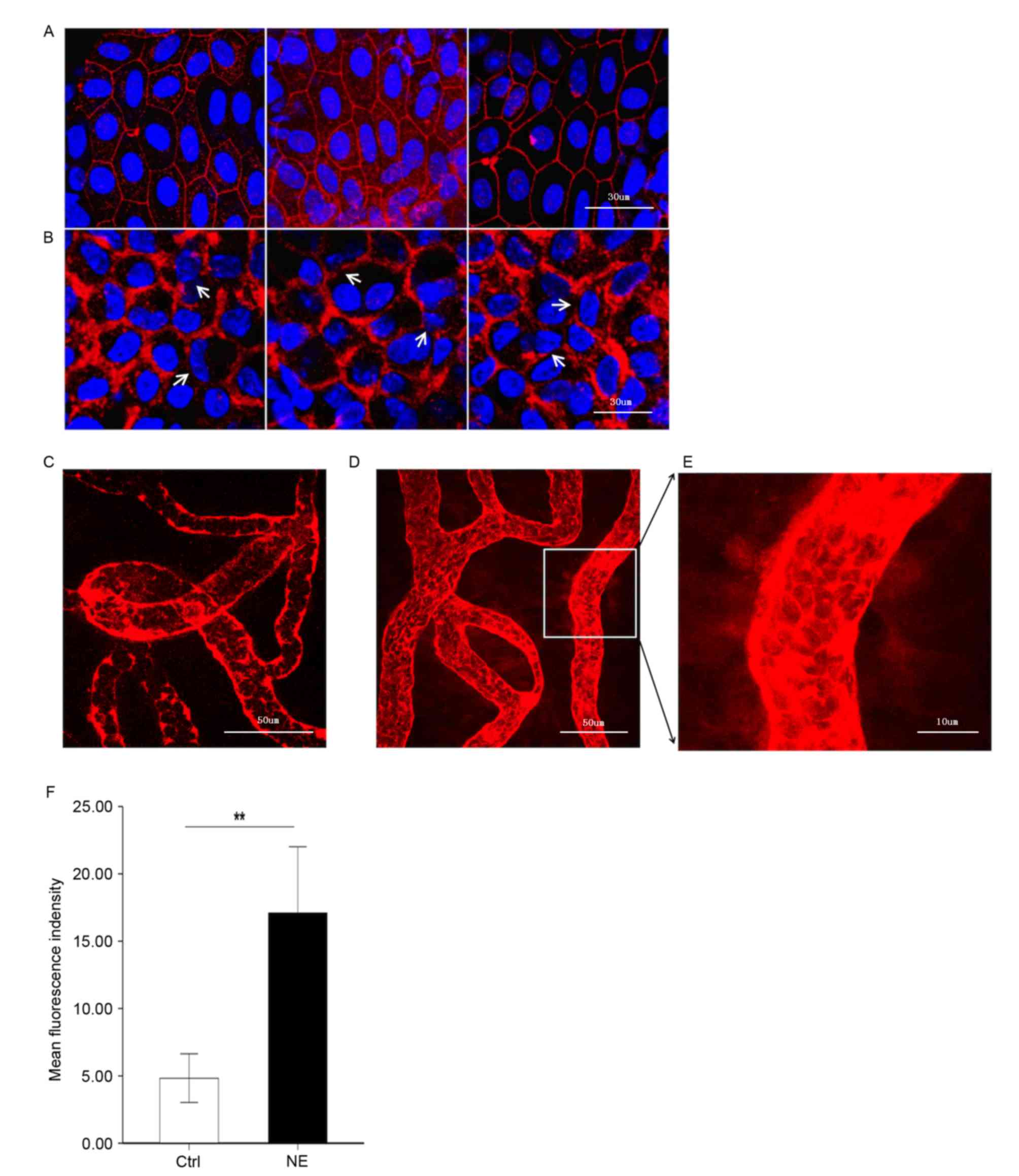|
1
|
Juhn SK, Hunter BA and Odland RM:
Blood-labyrinth barrier and fluid dynamics of the inner ear. Int
Tinnitus J. 7:72–83. 2001.PubMed/NCBI
|
|
2
|
Hirose K, Hartsock JJ, Johnson S, Santi P
and Salt AN: Systemic lipopolysaccharide compromises the
blood-labyrinth barrier and increases entry of serum fluorescein
into the perilymph. J Assoc Res Otolaryngol. 15:707–719. 2014.
View Article : Google Scholar : PubMed/NCBI
|
|
3
|
Juhn SK, Rybak LP and Prado S: Nature of
blood-labyrinth barrier in experimental conditions. Ann Otol Rhinol
Laryngol. 90:135–141. 1981. View Article : Google Scholar : PubMed/NCBI
|
|
4
|
Romero IA, Radewicz K, Jubin E, Michel CC,
Greenwood J, Couraud PO and Adamson P: Changes in cytoskeletal and
tight junctional proteins correlate with decreased permeability
induced by dexamethasone in cultured rat brain endothelial cells.
Neurosci Lett. 344:112–116. 2003. View Article : Google Scholar : PubMed/NCBI
|
|
5
|
Feng S, Cen J, Huang Y, Shen H, Yao L,
Wang Y and Chen Z: Matrix metalloproteinase-2 and −9 secreted by
leukemic cells increase the permeability of blood-brain barrier by
disrupting tight junction proteins. PLoS One. 6:e205992011.
View Article : Google Scholar : PubMed/NCBI
|
|
6
|
Yang Y, Dai M, Wilson TM, Omelchenko I,
Klimek JE, Wilmarth PA, David LL, Nuttall AL, Gillespie PG and Shi
X: Na+/K+-ATPase α1 identified as an abundant protein in the
blood-labyrinth barrier that plays an essential role in the barrier
integrity. PLoS One. 6:e165472011. View Article : Google Scholar : PubMed/NCBI
|
|
7
|
Dai M, Yang Y, Omelchenko I, Nuttall AL,
Kachelmeier A, Xiu R and Shi X: Bone marrow cell recruitment
mediated by inducible nitric oxide synthase/stromal cell-derived
factor-1alpha signaling repairs the acoustically damaged cochlear
blood-labyrinth barrier. Am J Pathol. 177:3089–3099. 2010.
View Article : Google Scholar : PubMed/NCBI
|
|
8
|
Hirose K and Liberman MC: Lateral wall
histopathology and endocochlear potential in the noise-damaged
mouse cochlea. J Assoc Res Otolaryngol. 4:339–352. 2003. View Article : Google Scholar : PubMed/NCBI
|
|
9
|
Wu YX, Zhu GX, Liu XQ, Sun F, Zhou K, Wang
S, Wang CM, Jia JW, Song JT and Lu LJ: Noise alters guinea pig's
blood-labyrinth barrier ultrastructure and permeability along with
a decrease of cochlear Claudin-5 and Occludin. BMC Neurosci.
15:1362014. View Article : Google Scholar : PubMed/NCBI
|
|
10
|
Fanning AS, Jameson BJ, Jesaitis LA and
Anderson JM: The tight junction protein ZO-1 establishes a link
between the transmembrane protein occludin and the actin
cytoskeleton. J Biol Chem. 273:29745–29753. 1998. View Article : Google Scholar : PubMed/NCBI
|
|
11
|
Hervé JC, Derangeon M, Sarrouilhe D and
Bourmeyster N: Influence of the scaffolding protein Zonula
Occludens (ZOs) on membrane channels. Biochim Biophys Acta.
1838:595–604. 2014. View Article : Google Scholar : PubMed/NCBI
|
|
12
|
Klein G, Vellenga E, Fraaije MW, Kamps WA
and de Bont ES: The possible role of matrix metalloproteinase
(MMP)-2 and MMP-9 in cancer, e.g. acute leukemia. Crit Rev Oncol
Hematol. 50:87–100. 2004. View Article : Google Scholar : PubMed/NCBI
|
|
13
|
Hu BH, Cai Q, Hu Z, Patel M, Bard J,
Jamison J and Coling D: Metalloproteinases and their associated
genes contribute to the functional integrity and noise-induced
damage in the cochlear sensory epithelium. J Neurosci.
32:14927–14941. 2012. View Article : Google Scholar : PubMed/NCBI
|
|
14
|
Setz C, Brand Y, Radojevic V, Hanusek C,
Mullen PJ, Levano S, Listyo A and Bodmer D: Matrix
metalloproteinases 2 and 9 in the cochlea: Expression and activity
after aminoglycoside exposition. Neuroscience. 181:28–39. 2011.
View Article : Google Scholar : PubMed/NCBI
|
|
15
|
Neng L, Zhang W, Hassan A, Zemla M,
Kachelmeier A, Fridberger A, Auer M and Shi X: Isolation and
culture of endothelial cells, pericytes and perivascular resident
macrophage-like melanocytes from the young mouse ear. Nat Protoc.
8:709–720. 2013. View Article : Google Scholar : PubMed/NCBI
|
|
16
|
Takeuchi S, Ando M, Sato T and Kakigi A:
Three-dimensional and ultrastructural relationships between
intermediate cells and capillaries in the gerbil stria vascularis.
Hear Res. 155:103–112. 2001. View Article : Google Scholar : PubMed/NCBI
|
|
17
|
Wolman M, Klatzo I, Chui E, Wilmes F,
Nishimoto K, Fujiwara K and Spatz M: Evaluation of the dye-protein
tracers in pathophysiology of the blood-brain barrier. Acta
Neuropathol. 54:55–61. 1981. View Article : Google Scholar : PubMed/NCBI
|
|
18
|
Yen LF, Wei VC, Kuo EY and Lai TW:
Distinct patterns of cerebral extravasation by evans blue and
sodium fluorescein in rats. PLoS One. 8:e685952013. View Article : Google Scholar : PubMed/NCBI
|
|
19
|
Shi X: Cochlear pericyte responses to
acoustic trauma and the involvement of hypoxia-inducible
factor-1alpha and vascular endothelial growth factor. Am J Pathol.
174:1692–1704. 2009. View Article : Google Scholar : PubMed/NCBI
|
|
20
|
Shi X: Resident macrophages in the
cochlear blood-labyrinth barrier and their renewal via migration of
bone-marrow-derived cells. Cell Tissue Res. 342:21–30. 2010.
View Article : Google Scholar : PubMed/NCBI
|
|
21
|
Hibino H, Nin F, Tsuzuki C and Kurachi Y:
How is the highly positive endocochlear potential formed? The
specific architecture of the stria vascularis and the roles of the
ion-transport apparatus. Pflugers Arch. 459:521–533. 2010.
View Article : Google Scholar : PubMed/NCBI
|
|
22
|
Suzuki M, Yamasoba T, Ishibashi T, Miller
JM and Kaga K: Effect of noise exposure on blood-labyrinth barrier
in guinea pigs. Hear Res. 164:12–18. 2002. View Article : Google Scholar : PubMed/NCBI
|
|
23
|
Hawkins BT, Lundeen TF, Norwood KM, Brooks
HL and Egleton RD: Increased blood-brain barrier permeability and
altered tight junctions in experimental diabetes in the rat:
Contribution of hyperglycaemia and matrix metalloproteinases.
Diabetologia. 50:202–211. 2007. View Article : Google Scholar : PubMed/NCBI
|
|
24
|
Szabova L, Son MY, Shi J, Sramko M, Yamada
SS, Swaim WD, Zerfas P, Kahan S and Holmbeck K: Membrane-type MMPs
are indispensable for placental labyrinth formation and
development. Blood. 116:5752–5761. 2010. View Article : Google Scholar : PubMed/NCBI
|
|
25
|
Page-McCaw A, Ewald AJ and Werb Z: Matrix
metalloproteinases and the regulation of tissue remodelling. Nat
Rev Mol Cell Biol. 8:221–233. 2007. View
Article : Google Scholar : PubMed/NCBI
|
|
26
|
Parks WC, Wilson CL and López-Boado YS:
Matrix metalloproteinases as modulators of inflammation and innate
immunity. Nat Rev Immunol. 4:617–629. 2004. View Article : Google Scholar : PubMed/NCBI
|
|
27
|
Rosenberg GA: Matrix metalloproteinases
and their multiple roles in neurodegenerative diseases. Lancet
Neurol. 8:205–216. 2009. View Article : Google Scholar : PubMed/NCBI
|
|
28
|
Visse R and Nagase H: Matrix
metalloproteinases and tissue inhibitors of metalloproteinases:
Structure, function, and biochemistry. Circ Res. 92:827–839. 2003.
View Article : Google Scholar : PubMed/NCBI
|
|
29
|
Hernandez-Barrantes S, Bernardo M, Toth M
and Fridman R: Regulation of membrane type-matrix
metalloproteinases. Semin Cancer Biol. 12:131–138. 2002. View Article : Google Scholar : PubMed/NCBI
|
|
30
|
Chelladurai P, Seeger W and Pullamsetti
SS: Matrix metalloproteinases and their inhibitors in pulmonary
hypertension. Eur Respir J. 40:766–782. 2012. View Article : Google Scholar : PubMed/NCBI
|

















